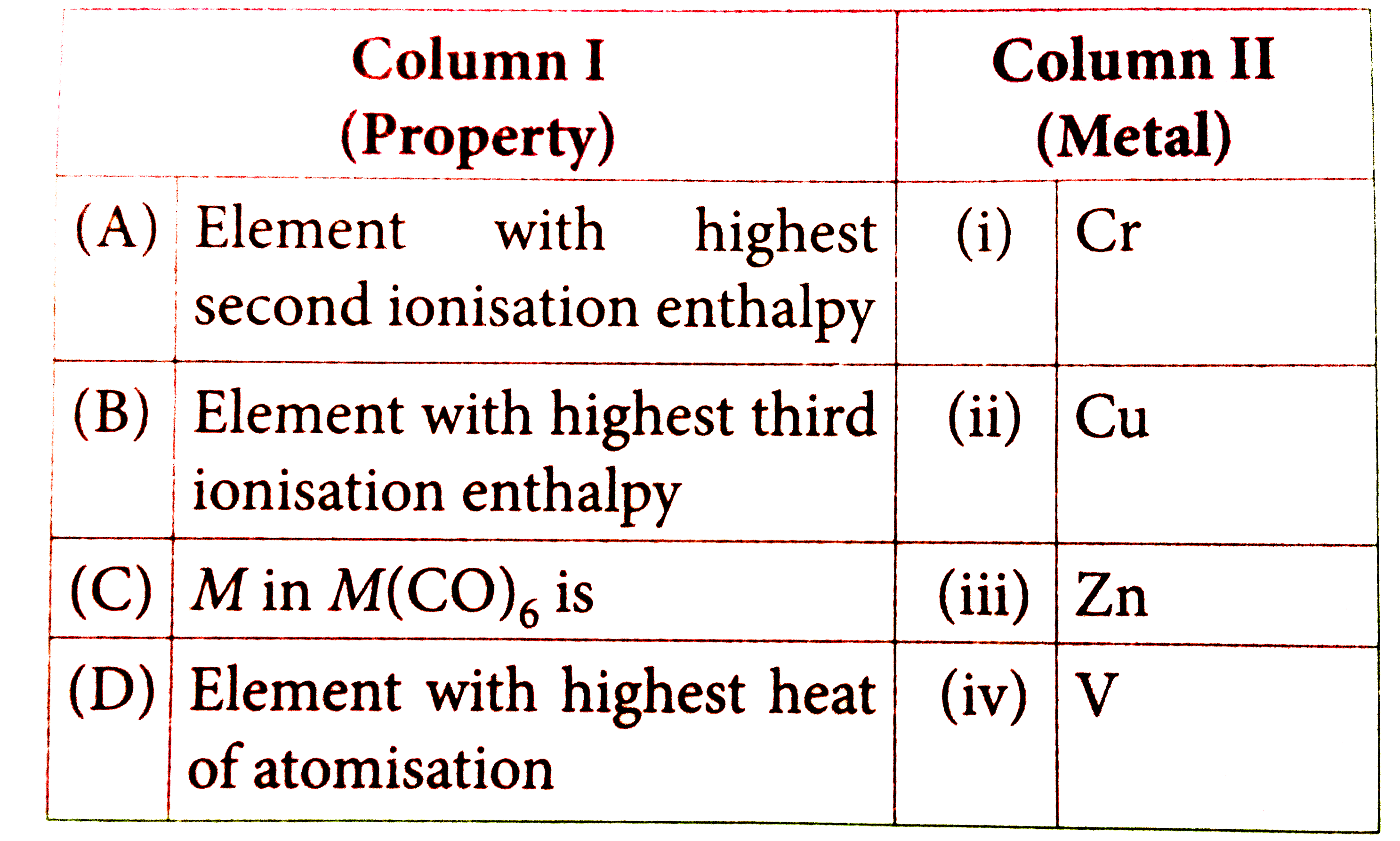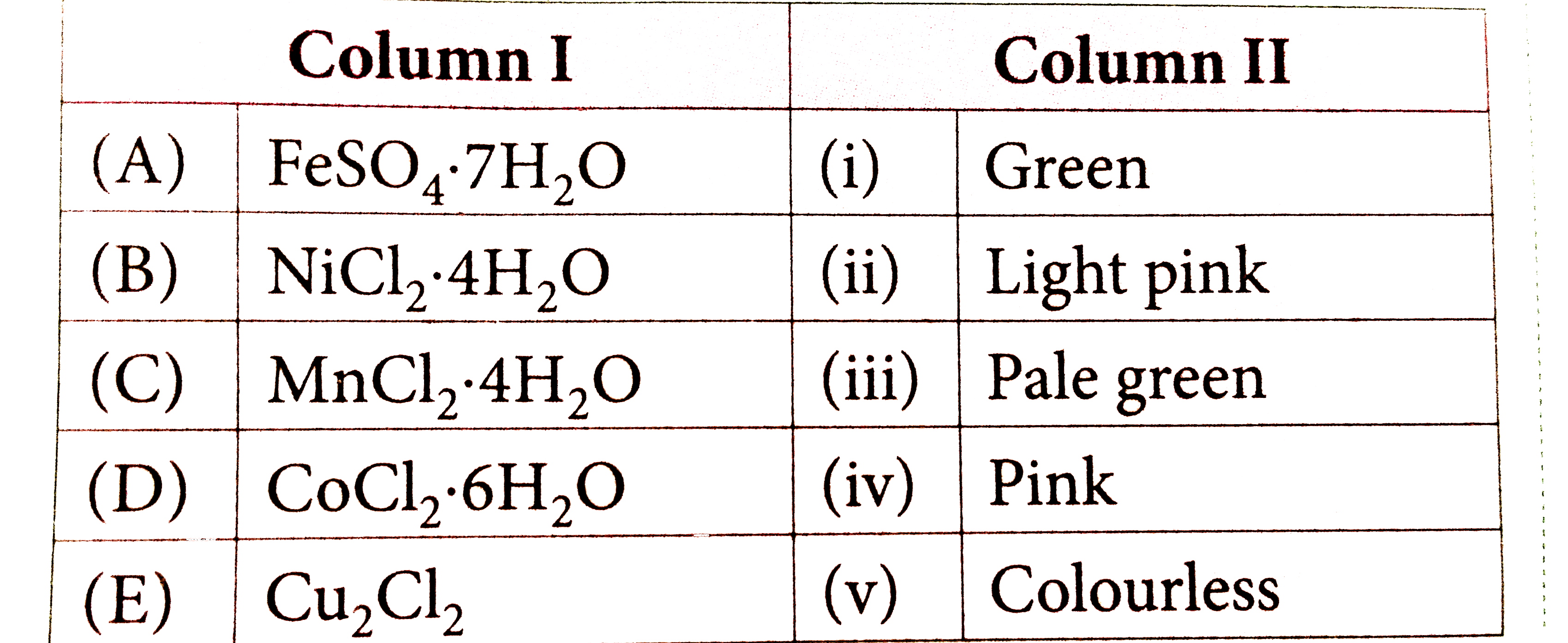Complete Solutions to General Properties Of The Transition Elements of chapter THE D- AND F- BLOCK ELEMENTS of Class 12 book with complete answers and questions
| Class 12 | CHEMISTRY |
| Chapter | THE D- AND F- BLOCK ELEMENTS |
| NCERT FINGERTIPS | General Properties Of The Transition Elements |
| Number Of Questions | 39 |
| Academic Year | 2023-24 |
The melting points of Cu, Ag and Au follow the order
View SolutionThe melting point of copper is higher than that of zinc because
View SolutionDue to lanthanoid contraction which of the following properties is not expected to be similar in the sme vertical columns of second and third row transition elements ?
View SolutionZr(Z=40) and Hf(Z=72) have similar atomic and ionic radii because of:
View SolutionThe second and third row elements of transition maetals resemle each other much more than they resemble the first row because of
View SolutionReactivity of transition elements decreases almost regularly from Sc to Cu because of
View SolutionWhich of the following is not correctly matched with the given example ?
View Solution`Cu^(+)` ion is not stable in aqueous solution because because of dispropotionation reaction. `E^(@)` value of disproportionation of `Cu^(+)` is
`[E_(Cu^(2+)//Cu^(+))^(@)=+ 0.15 V, E_(Cu^(2+)//Cu)^(@)=0.34 V]`
View SolutionThe first ionisation energies of the elements of the first transition series `(TitoCu)`
View SolutionMatch the column I with column II and mark the appropriate choice.

View SolutionIdentify the species in which the metal atom is in +6 oxidation state.
View SolutionIn which of the following compounds manganese has oxidation number equal to that of iodine in `KIO_4`?
View Solution`E_(Mn^(3+)//Mn^(2+))^@`is highly positive than that of `E_(Cr^(3+)//Cr^(2+))^@orE_(Fe^(3+)//Fe^(2+))^@` because
View SolutionThe correct order of `E_(M^(2+)//M)^(@)` Values with negative sign for the four successive elements `Cr, Mn, Fe` and `Co` is:
View SolutionWhich of the following d-block element has half - filled penultimate as well as valence subshell ?
View Solution`Fe^(3+)` compounds are more stable than `Fe^(2+)` compounds because
View SolutionThe salts of Cu in +1 oxidation state are unstable because
View SolutionIn which of the following pairs of ions, the higher oxidation state in aqueous solution is more stable than the other?
I. `TI^(+), TI^(3+)` II. `Cu^(+),Cu^(2+)`
III. `Cr^(2+),Cr^(3+)` IV. `V^(2+),V^4+`
View Solution`CuSO_4` is paramagnetic while `ZnSO_4` is diamagnetic because
View SolutionWhich of the following transition metal ions has highest magnetic moment ?
View SolutionSelect the correct option, among Sc(III) , Ti(IV), Pd(II) and Cu(II) ions
View SolutionThe correct order of the number of unpaired electrons in the ions `Cu^(2+), Ni^(2+), Fe^(3+)`, and `Cr^(3+)`is
View SolutionCalculate the magnetic moment of a divalent ion in aqueous solution if its atomic number is 25.
View SolutionArrange the following in increasing value of magnetic moments.
(i) `[Fe(Cn)_6]^(4-)` (ii) ` [Fe(CN)_6]^(3-)`
(iii) `[Cr(NH_3)_6]^(3+)` (iv) `[Ni(H_2O)_4]^(2+)`
View SolutionWhich of the following statements is not correct about magnetic behaviour of substances ?
View SolutionThe number of unpaired electrons in gaseous species of `Mn^(3+), Cr^(3+)` and `V^(3+)` respectively are………….and most stable species is…………..
View SolutionWhich of the following arrangements represent the correct order of the property stated against it ?
(i) `Ni^(2+) lt Co^(2+) lt Fe^(2+) lt Mn^(2+)` : ionic size
(ii) `Co^(3+) lt Fe^(3+) lt Cr^(3+) lt Sc^(3+)` : stability in aqueious solution
(iii) `Sc lt Ti lt Cr lt Mn` : number of oxidation states
(iv) `V^(2+) lt Cr^(2+) lt Mn^(2+) lt Fe^(2+)` : paramagnetic behaviour
View SolutionMatch the column I with column II and mark the appropriate choice.

View SolutionWhich of the following transition metal ions is colourless ?
View SolutionAmongst `TiF_6^(2-), CoF_6^(3-), Cu_2Cl_2" and " NiCl_4^(2-)`, which are the colourless species ? (atomic number of Ti = 22 , Co = 27, Cu = 29, Ni = 28)
View SolutionWhich of the following compounds is not coloured ?
View SolutionCompound that is both paramagnetic and coloured is:
View SolutionMost of the transition metals exhibit
(i) paramagnetic behaviour
(ii) diamagnetic behaciour
(iii) variable oxidation states
(iv) formation of coloured ions
View SolutionFor `Zn^(2), Ni^(2+), Cu^(2+) and Cr^(2+)` which of the following statements is correct ?
View SolutionColour of transition metal ions are due to absorption of some wavelength. This results in
View SolutionWhich group contains coloured ions out of the following ?
1. `Cu^+` 2. `Ti^(4+)` 3. `Co^(2+)` 4. `Fe^(2+)`
View SolutionTransition metals make the most efficient catalysts because of their ability to
View SolutionInterstitial compounds are
View SolutionTransition elements form binary compounds with halogens. Which of the following elements will form `MF_(3)` type compounds?
View Solution
General Properties Of The Transition Elements questions and complete solutions for chapter THE D- AND F- BLOCK ELEMENTS of MTG CHEMISTRY (ENGLISH) of Class 12
All Exercises from NCERT FINGERTIPS Class 12 CHEMISTRY THE D- AND F- BLOCK ELEMENTS
- Application Of D And F Block Elements
- ASSERTION & REASON
- Assertion And Reason
- Electronic Configuration Of D Block Elements
- EXEMPLER PROBLEMS
- General Properties Of The Transition Elements
- Higher Order Thinking Skills
- HOTS
- MCQs
- NCERT Exemplar
- Some Important Compounds Of Transition Elements
- The Actinoids
- The Lanthanoids